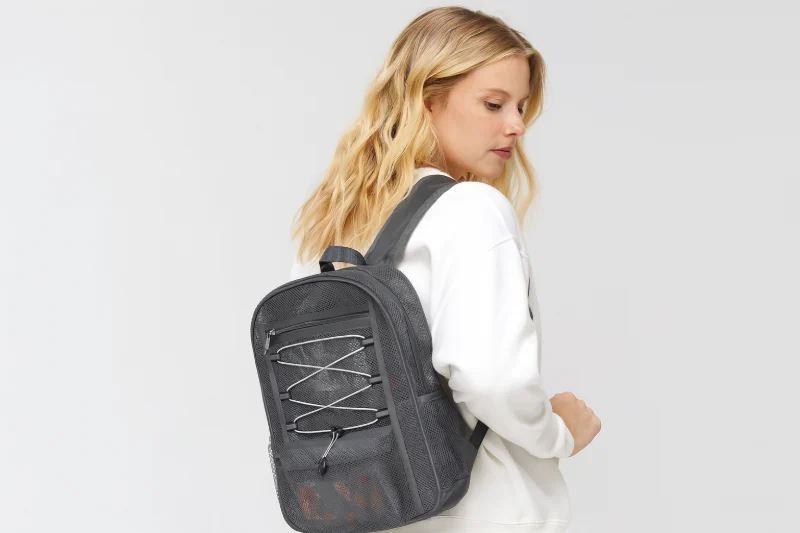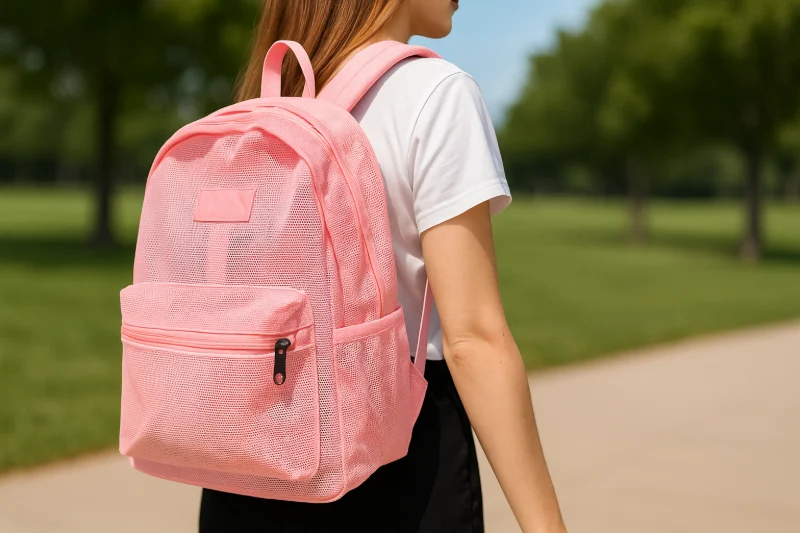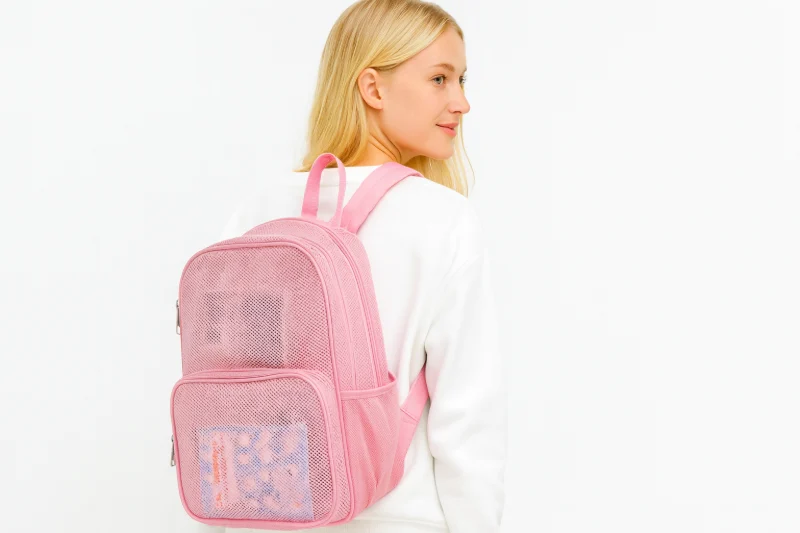
If you’ve ever opened your backpack after a summer workout or a day at the beach only to find your clothes damp, stuffy, and carrying an unpleasant odor—you’re definitely not alone. Traditional backpacks, though sturdy, tend to trap moisture and block airflow, making them unsuitable for carrying wet clothes, beach towels, or sports gear.
This is exactly where the mesh backpack comes in. Made with breathable mesh fabric, it allows air to circulate freely inside the bag, helping your items dry faster and stay fresh. Whether you’re heading to the gym, the pool, or just out for a relaxed weekend, a mesh backpack keeps your essentials light, organized, and easy to carry. Today, mesh backpacks are gaining more and more attention—not because they’re a new idea, but because they perfectly fit the modern lifestyle that values activity, outdoor comfort, and sustainability.
A mesh backpack is a lightweight bag made from open-weave, breathable fabric such as polyester or nylon mesh. Unlike solid-fabric backpacks, its perforated surface allows air to circulate freely — keeping the contents ventilated and dry. It’s commonly used for gym, travel, or beach trips where ventilation and quick-drying performance matter most.
The open-weave mesh structure allows continuous airflow, effectively reducing moisture buildup and unpleasant odors. For those carrying sportswear, swimsuits, or other damp items, this design keeps the interior fresh and prevents mold growth.
Made from polyester or nylon mesh, these backpacks are typically 20% to 50% lighter than regular fabric ones. The lightweight design reduces shoulder pressure and makes long periods of carrying much more comfortable.
The mesh surface doesn’t easily trap dust or dirt, and cleaning is simple—just rinse with water or pat gently to restore its freshness. For people who are often on the go, this feature saves significant maintenance time.
The fine mesh allows sand and water to drain out naturally, keeping the inside clean and dry even in humid environments like beaches or swimming pools.
The semi-transparent mesh makes it easy to locate items quickly without rummaging, which is especially convenient in gyms, locker rooms, or outdoor settings where quick access matters.

Because the mesh fabric is thin and flexible, mesh backpacks are not suitable for carrying heavy loads over long periods, as the material may stretch or lose shape.
How to Improve: Choose models with reinforced shoulder straps or a strengthened bottom panel, and avoid loading items beyond everyday weight limits to extend the bag’s lifespan.
The semi-transparent design makes organization easier but also exposes the contents to others.
How to Improve: Use small pouches or inner liners inside the backpack to store valuables or personal items separately, keeping things tidy and more private.
Mesh fabric lacks a waterproof coating, so water can easily seep through during rain, dampening the contents.
How to Improve: Add a waterproof inner bag or carry a compact rain cover to prevent moisture from getting inside.
The fine mesh can snag or tear when rubbed against rough or sharp surfaces.
How to Improve: Avoid direct contact with abrasive or pointed surfaces, inspect the bag regularly, and repair small tears early to maintain protection.
Mesh fabric is soft and flexible, unlike rigid materials that hold their shape; it may collapse when partially filled.
How to Improve: Opt for backpacks with light inner linings or base supports to help the bag maintain its form and ensure even weight distribution inside.
Mesh backpacks are breathable. True
Mesh backpacks are made with open-weave fabrics that allow air to circulate freely, preventing moisture buildup and odor.
Mesh backpacks are suitable for carrying laptops and electronics. False
Because of their porous structure and lack of padding, mesh backpacks offer little protection for electronic devices.
Mesh backpacks are popular among students for their light weight and see-through design. They make school security checks easier and help keep books and supplies organized and easy to find.
At the pool or water park, mesh bags are unbeatable. Toss in your swimsuit, towel, or goggles — the water drains naturally, and everything dries faster on the way home.
Travelers appreciate how compact and lightweight it is. The bag folds flat inside luggage and doubles as a handy daypack for short trips or spontaneous adventures.
On the beach, the mesh design lets sand fall right through instead of collecting at the bottom. Pack your towel, sunscreen, and flip-flops — everything stays clean and easy to carry.
Pet owners love its breathable structure for carrying toys, towels, or leashes. Even if something inside gets damp, the airflow keeps the bag fresh and odor-free.

In appearance, nylon mesh tends to be finer and smoother, while polyester mesh has a slightly stiffer texture and a tighter weave. Both perform exceptionally well in terms of abrasion resistance and longevity, which is why they are the most widely used base fabrics in the production of mesh backpacks.
Both mesh backpacks and clear backpacks fall under the category of “see-through bags,” but their design concepts and user experiences differ significantly. The main difference lies in the material structure: mesh backpacks are made from breathable fabrics with open holes, while clear backpacks use smooth plastic materials such as PVC or TPU. The former emphasizes lightness and ventilation, whereas the latter focuses on safety and visibility.
The table below compares their main characteristics:
| Feature | Mesh Backpack | Clear Backpack |
|---|---|---|
| Visibility | Semi-transparent, partially shows contents | Fully transparent, contents are completely visible |
| Privacy | Offers partial privacy | No privacy protection |
| Breathability | Excellent, allows free airflow | None |
| Weight | Lighter | Slightly heavier |
| Durability | High | Medium |
| Texture | Flexible and comfortable | Firm and slightly rigid |
| Ease of Cleaning | Easy to rinse or wash | Wipe-clean and easy to maintain |
| Use Cases | Sports, gym, beach, everyday use | Schools, stadiums, security checks |
| Waterproofness | No (quick-drying but not waterproof) | Yes (waterproof but non-breathable) |
Overall, mesh backpacks focus on ventilation and lightweight comfort, while clear backpacks emphasize security and visibility. Though similar in appearance, they serve different purposes — one aims for practicality and comfort, the other for compliance and transparency.
Strictly speaking, mesh backpacks are a relatively eco-friendly choice. They can be reused for many years, reducing reliance on single-use packaging, and their lightweight, quick-dry materials help lower water and energy consumption during washing and daily use. However, their sustainability does not depend solely on the material itself but rather on how long and how responsibly they are used — the longer the lifespan and the more single-use items they replace, the greater their environmental value becomes.
Nylon mesh is softer and more flexible than polyester mesh. True
Nylon fibers have higher elasticity and smoother texture, providing a softer feel compared to polyester.
Mesh backpacks can carry heavy loads without stretching. False
Lightweight mesh material is not designed for high loads and may stretch or lose shape over time.
A mesh backpack is a bag type that combines practicality with a sense of design, making it an excellent choice for brand customization. Whether for sports teams, school groups, e-commerce brands, or corporate giveaways, the size, color, and structure can be tailored to different purposes so that the overall style aligns more closely with the brand’s image.
The factory can adjust mesh density, strap style, color schemes, and accessory combinations as needed, ensuring that each mesh backpack reflects a distinct brand identity. This form of customization not only increases brand visibility in everyday use but also turns a simple backpack into an extension of brand philosophy — lightweight, durable, comfortable, and instantly recognizable.
At Yanxin Bag, we believe a great backpack is more than a carrying tool — it’s an expression of brand values and lifestyle. If you’re looking for a mesh backpack that combines breathability, lightness, and practicality, we can provide complete support from structural design to mass production.
Whether you’re developing a plan for a team, an event, or an e-commerce brand, we can create custom mesh backpacks tailored to your needs — balancing aesthetics, durability, and cost efficiency.
Reach out to the Yanxin Bag team and let us help your brand be seen by the world in a lighter, longer-lasting way.
A Complete Guide For Best Reusable Produce Bags
This guide explores reusable produce bags, detailing their benefits and a variety of specific styles. It provides practical selection advice covering materials, designs, sizing, printing options, and cleaning methods.
How to easily protect delicates in the wash?
This article explains the function and benefits of mesh laundry bags, outlines suitable garment types, and provides usage steps, care tips, and purchasing advice.
What are the pros and cons of using mesh bags?
This guide defines mesh produce bags and explores their advantages and limitations. It also offers practical advice on usage, cleaning, maintenance, and where to buy them.
How to properly clean and maintain cotton mesh bags?
This article explains the importance of cleaning, provides specific hand and machine washing methods, drying tips to prevent mold, and highlights common care mistakes to avoid.
Why are mesh bags a top choice for summer activities?
This article details the reasons for mesh bags’ summer popularity, covers the industries and scenarios they suit, and provides a guide to choosing between polyester, nylon, and cotton mesh materials.

Get a free quote and expert consultation today. Let's bring your brand vision to life.
Answer: The main benefits include excellent ventilation (helping reduce dampness and odor), lightweight structure (often 20–50% lighter than regular fabric bags), easy cleaning (mesh does not retain dirt easily), sand- and moisture-resistance (mesh allows water and sand to drain), and semi-transparency (easier to locate items inside).
Answer: Limitations include low load capacity, low privacy, lack of waterproofing, susceptibility to snags, and weak structural support. Improvements can include selecting thicker shoulder straps or reinforced bottoms, using inner pouches for privacy, inserting waterproof liners or rain covers, avoiding sharp surfaces, and incorporating internal frames or base supports.
Answer: Mesh backpacks are primarily made from two common synthetic fibers: nylon mesh and polyester mesh. These fabrics are lightweight, tough, and breathable, making them ideal choices for mesh backpack construction.
Answer: Mesh backpacks are semi-transparent, offering partial visibility and retaining some privacy. In contrast, clear backpacks are fully transparent, allowing complete visibility into their contents and offering no privacy.
Answer: In many school districts that mandate clear or see-through bags, mesh backpacks are often accepted as the transparent alternative, though local policy may prefer clear plastic ones.
Answer: Yes. Due to their open weave and lightweight nature, mesh backpacks facilitate faster evaporation of moisture compared to denser fabrics or solid plastic designs.
Answer: Yes. Mesh backpacks are often used as custom or branded products. Enterprises, sports teams, school groups, or online retailers choose size, color, structure, and brand-identifying features to reflect their image.
Answer: Yes. The breathable mesh construction allows air circulation, helping to reduce moisture accumulation and odor, which is particularly valuable for carrying sweaty clothes or other damp items.
Answer: Absolutely. The mesh allows water and sand to drain out naturally, making them well-suited for beach towels, swimwear, and other wet items.
Answer: Because mesh backpacks are lighter in material, they impose less weight overhead, reducing shoulder strain during extended wear. However, solid fabric backpacks may offer better structural support and protection for heavy items.

Order or no-order we are Always here to help you!
We will contact you within 1 working day, please pay attention to the email with the suffix “@yanxinbag.com”.
Order or no-order we are Always here to help you!
We will contact you within 1 working day, please pay attention to the email with the suffix “@yanxinbag.com”.